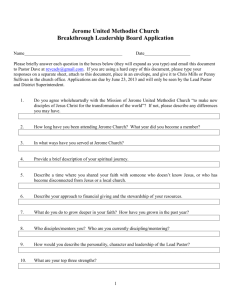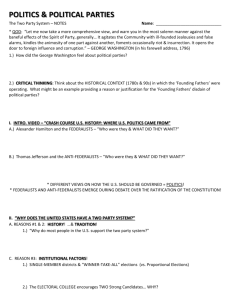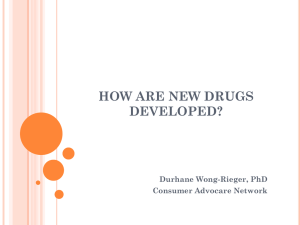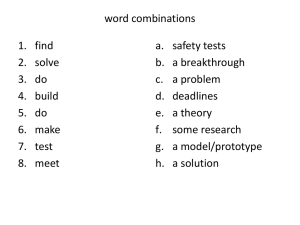Origins of Party Formation and New Party Success in Advanced
advertisement
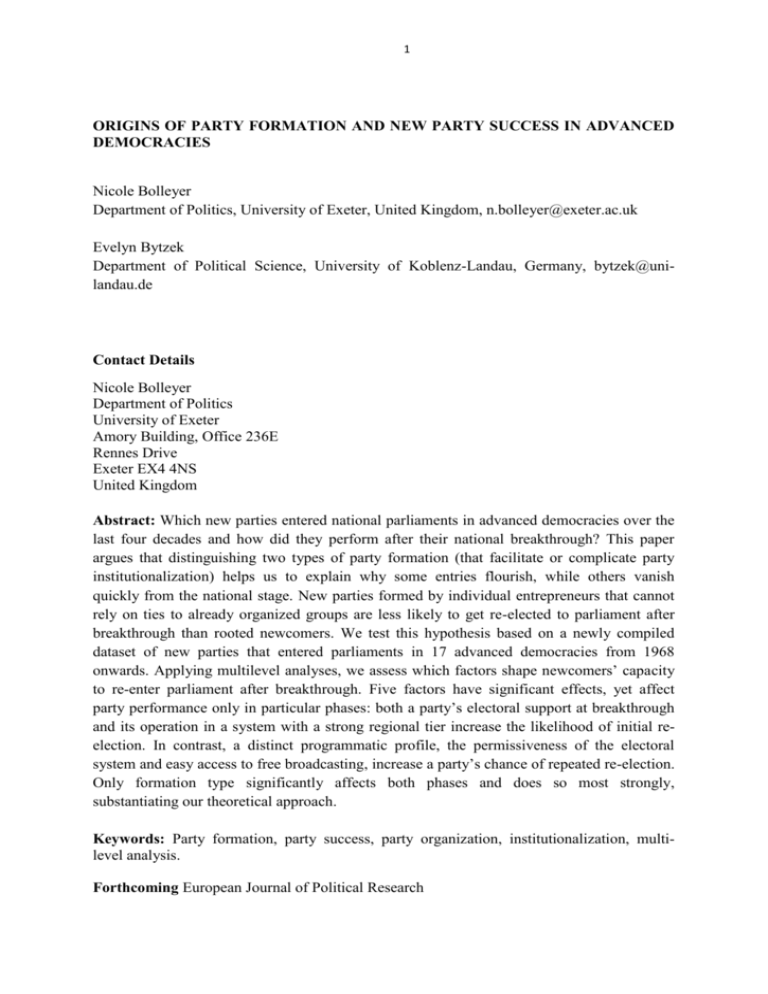
1 ORIGINS OF PARTY FORMATION AND NEW PARTY SUCCESS IN ADVANCED DEMOCRACIES Nicole Bolleyer Department of Politics, University of Exeter, United Kingdom, n.bolleyer@exeter.ac.uk Evelyn Bytzek Department of Political Science, University of Koblenz-Landau, Germany, bytzek@unilandau.de Contact Details Nicole Bolleyer Department of Politics University of Exeter Amory Building, Office 236E Rennes Drive Exeter EX4 4NS United Kingdom Abstract: Which new parties entered national parliaments in advanced democracies over the last four decades and how did they perform after their national breakthrough? This paper argues that distinguishing two types of party formation (that facilitate or complicate party institutionalization) helps us to explain why some entries flourish, while others vanish quickly from the national stage. New parties formed by individual entrepreneurs that cannot rely on ties to already organized groups are less likely to get re-elected to parliament after breakthrough than rooted newcomers. We test this hypothesis based on a newly compiled dataset of new parties that entered parliaments in 17 advanced democracies from 1968 onwards. Applying multilevel analyses, we assess which factors shape newcomers’ capacity to re-enter parliament after breakthrough. Five factors have significant effects, yet affect party performance only in particular phases: both a party’s electoral support at breakthrough and its operation in a system with a strong regional tier increase the likelihood of initial reelection. In contrast, a distinct programmatic profile, the permissiveness of the electoral system and easy access to free broadcasting, increase a party’s chance of repeated re-election. Only formation type significantly affects both phases and does so most strongly, substantiating our theoretical approach. Keywords: Party formation, party success, party organization, institutionalization, multilevel analysis. Forthcoming European Journal of Political Research 2 INTRODUCTION: THE RISE OF NEW PARTIES IN ADVANCED DEMOCRACIES AND THEIR SUSTAINABILITY Only a fraction of new parties ever gains national parliamentary representation. Over the last decades, however, more and more newcomers have managed to overcome this hurdle and to increase their vote share significantly.1 Yet although a party’s national breakthrough is considered as a major event in every party’s history (e.g. Pedersen 1982; Lucardie 2000; Krouwel and Lucardie 2008) and by now cross-national research increasingly deals with the effects of government participation on new parties (e.g. Deschouwer 2008; McDonnell and Newell 2011), one fundamental puzzle remains still unresolved in the study of new parties in advanced democracies: For which new parties does parliamentary entry form the start of a longer career in the national arena and which ones stay there only briefly and why? It is by no means automatic that a new party can exploit its entry success in its favour. Some parties fade away quietly having failed to re-enter parliament early on, others spectacularly disintegrate after breakthrough, a less frequent but much more noticed fate (e.g., Aylott 1995; Lucardie and Ghillebaert 2008). Whether new parties can defend their niche after having entered parliament is essential to evaluate whether their entry introduces substantive change in consolidated party systems, rather than remaining a punctual expression of citizen dissatisfaction and protest. In an attempt to address this question, we argue that the structural conditions in which new parties are formed facilitate or complicate party institutionalization and, therefore, constitute an important factor that needs to be considered when accounting for newcomers’ diverse performance patterns. Since a long-term presence on the national level is one important indication of new parties’ relevance, the natural focus of existing studies has been on those parties that have stayed around. Green parties, for instance, a new party family, whose members have shown a considerable capacity to attract and consolidate support (e.g. Poguntke 2002a), have received 1 Recognizing the importance of the rise of new parties in advanced democracies, we find a wide range of insightful cross-national studies focusing either on the evolution of particular party families (e.g., Kitschelt 1989; Poguntke 2002a; Ignazi 2003; Carter 2005; Mudde 2007; Spoon 2009; Art 2011; for a study systematically covering several party families see Meguid 2008) or on cross-national patterns of new party emergence and entry (e.g. Mair 1999; Hug 2001; Abedi 2004; Tavits 2006). 3 considerable attention, as did the new radical or populist right later on, whose members although as a group less sustainable (e.g. Carter 2005; Mudde 2007) - attracted significant vote shares in a range of Western democracies. New left parties, in contrast, are rarely the subject of systematic comparative analysis (but see Dunphy and Bale 2011). This focus has two methodological implications: First, starting out with a focus on specific party families restricts our capacity to explore broader conditions for the sustainability of new parties after breakthrough, especially since this focus, in practice, implies a focus on successful cases, while leaving out a wide range of failure cases.2 Second, a focus on party families that are ideologically new or distinct from the ‘mainstream offer’ limits our ability to explore which of the majority of new entries that emulate mainstream ideologies succeed or fail, and why they do so. To circumvent these problems, we start out from a conception of new parties as ‘organizationally new’, detach our criteria for case selection, i.e. our definition of newness, from parties’ programmatic profiles and focus on their relative organizational (im)maturity instead. To explore party performance after national breakthrough we look at those new parties that have won a seat in the first house of their national parliament at least once (irrespective of vote shares or programmatic profile) across 17 advanced democracies. The 120 new parties that meet these criteria, and are thus included in our analyses, assure the coverage of a wide range of performance trajectories including the variety of failure cases. Further, we avoid the starting assumption that new parties only succeed when representing new or neglected issues, which might lead to the bypassing of otherwise relevant cases. New parties might ‘wilfully fight on already occupied territory’ and still be successful, a possibility recognized in the study of new democracies but rarely explicitly considered in the context of established democracies (Sikk 2011: 3). This conceptual choice is equally essential in light of the explanatory goal of this paper, the exploration of factors driving new parties’ sustainability in the national arena after their parliamentary breakthrough, rather than accounting for parliamentary entry (e.g. Krouwel and Lucardie 2008) or entry into national elections (e.g. Hug 2001, Tavits 2006). Deliberately 2 See on the methodological implications Geddes (1990). 4 shifting the analytical focus to new party sustainability on the national level during a particularly vulnerable phase of party development, we argue that a party’s capacity to rely on ties to societal groups which pre-date a newcomer’s formation, so called promoter organizations, make it more likely that a party is able to sustain support after parliamentary breakthrough. In the following, we justify our empirical focus on new party sustainability after parliamentary breakthrough. Drawing on the theoretical literature, we identify party origin as a condition that increases the likelihood of a new party to institutionalize and thus to be sustainable. After having introduced our conception of ‘newness’, specified our measure of party origin and introduced a range of controls, the influence of party origin is tested on the basis of a genuinely new dataset comprising new parties across 17 advanced democracies. We conclude with the broader repercussions of our findings. WHY STUDY NEW PARTY SUSTAINABILITY AFTER BREAKTHROUGH? Case studies suggest that we cannot conclude from a party’s breakthrough success its medium- and long-term performance, as the dramatic disintegration of newcomers that entered parliaments with extensive vote shares3, and the resilience of those new parties that never won more than a few vote percentages,4 illustrate. To systematically account for these discrepancies, we focus on party sustainability, defined as the capacity of a new party to sustain initial support (which allowed it to enter national parliament in the first place) to such an extent that a party can re-enter parliament and thereby maintain a national presence. Initial failure after parliamentary entry has long-lasting consequences and comebacks are rare, mirroring our conceptualization of new parties as ‘organizationally new’. Their common denominator is the lack of a fully developed and consolidated infrastructure, which is most pronounced in the early stages of a newcomer’s career. Further, we look at sustainability in terms of maintaining access to the parliamentary arena (and the resources attached to this, 3 Prominent examples are the Dutch Pim Fortuyn List and New Democracy (Sweden). Examples are the French Greens (Les Verts) or the Swiss Federal Democratic Union (Eidgenössische Demokratische Union). 4 5 e.g. parliamentary assistants, parliamentary subsidies, media attention), access which all parties in our analysis have at least achieved once, to assure comparability across cases. The capacity of assuring re-election, and thus parliamentary representation, is more clear-cut and immediately comparable than relative vote gains or losses, which have different repercussions for a party’s resource access depending on the institutional setting (e.g. electoral thresholds). Sustainability, Party Institutionalization and the Importance of Party Origin Trying to account for party sustainability rather than short-term performance, a range of existing studies stress the importance of organizational factors. In his seminal study on the new populist right, Mudde (2007) argued that organization is particularly likely to play an important role for its capacity to exploit its initial success effectively by assuring the party’s functioning in public office and protecting its support base. Simultaneously, seminal studies on party development indicate that the origin of parties shapes their evolution in the medium and long term by influencing whether and to what extent parties institutionalize (Duverger 1981; Panebianco 1988). Institutionalization denotes a process by which party followers develop an interest in the survival of a party as such, independent of its current leadership (Panebianco 1988: 18-20; 53-55). Through an increasing routinization, intra-organizational processes become more rule-guided and less dominated by the idiosyncratic choices of leaders, a process which consolidates decisionmaking (Panebianco 1988: 49; 53). Value infusion, another dimension of institutionalization, results from party members’ and party representatives’ emotional attachment to the party (Levitsky 1998: 79). Both dimensions affect how well a party as an organization can cope with the pressures of public office by improving its capacities of coordination and conflict-resolution and decreasing the likelihood of defections. If, as argued in the literature, institutionalization helps a party to function as an organization facing conflicting pressures, one can plausibly expect a party’s origin to affect new party sustainability as far as formative conditions are likely to support the institutionalization of a newly formed party. While Panebianco (1988) stresses the importance of party origin, 6 reflecting his focus on long-established parties, he considers the emancipation of parties from external group support as part of a successful institutionalization process. Being more concerned with the sustainability of new parties, the literature on (less developed) parties in new democracies indicates that external group support can help still fluid party organizations to stabilize a support base instead (Randall and Svåsand 2002). The latter perspective leads us to distinguish two very different starting-points for new party development: parties formed by individual entrepreneurs5 and rooted party formations. Reflecting the same rationale, in a comparative study of the Norwegian and the Danish Progress Party, Harmel and Svåsand (1993) introduced the concept of the entrepreneurial party, new parties founded by individuals who are not affiliated to already organized groups. The counter-image of entrepreneurial newcomers are new parties supported by already existing organizations or groups, which promote the new formation and contribute resources to build a party infrastructure, a type of structural back-up that is most crucial in the early years of a party’s evolution, when a party is particularly vulnerable. While Green parties supported by environmental movements spring to mind as core examples (e.g. Kitschelt 1989; Poguntke 2002a), the variety of promoter organizations for rooted new parties is wide, ranging from fascist groups, nationalist movements, religious groups or unions, to extremist groupings on the left (e.g. Duverger 1981; Poguntke 2006; Allern and Bale 2011; Art 2011). In essence, we expect rooted new parties to be more sustainable, since they are more likely to institutionalize. The theoretical rationale is straightforward: party institutionalization is costly. It requires the set-up of effective screening and recruitment mechanisms able to select loyal as well as capable followers and candidates for public office. According to Wellhofer and Hennessey, the selection of a social base from which to recruit is a crucial phase in a party’s development (1974: 138-9). Similar to Panebianco (1988), they portray this selection on behalf of a party’s founding elite as an open one. Quite often, however, a party’s social base is, at least in part, predefined by those party founders’ backgrounds, their affiliation to some already existing groups and social organizations. This naturally affects the social base which can be ‘credibly’ chosen by founding elites. This can be read as a constraint on the founders’ leeway but once one considers that new parties tend to initially operate in a context of scarcity, such ties form a crucial resource exploitable for party institutionalization. These Different from Krouwel’s and Lucardie’s definition (2008), our conception suggests that entrepreneurs can be outsiders to politics or professional politicians who leave their party to found a new one. 5 7 ties provide access to a pool of committed activists able to fill positions in the new party and to run for (and possibly perform in) public office. Due to followers’ already established group affiliations, they are more inclined to identify with the newly formed party and such a basic emotional attachment makes their behaviour more predictable. They are less likely to defect even at stages when the party as organization is still underdeveloped, an orientation which institutionalization, in the form of value infusion, is supposed to generate. The affiliation to promoter groups functions as a first ‘natural pre-selection mechanism’ for a party that initially has very little capacity to weed out opportunists. Furthermore, the ability to recruit people who have the experience to operate in other social organizations is advantageous for routinization since they are used to following certain procedures and likely to possess basic managerial skills. Finally, ties to groups that predate party formation are likely to have implications for the orientation of the founders who are supposed to initiate an institutionalization process (Krouwel and Lucardie 2008: 282-3). This is important since we cannot simply assume that ‘leaders will emerge to meet the demands of the [party] organizational imperative’ (Wellhofer and Hennessey 1974: 139) [insertion by authors]. Founding actors with leadership aspirations and simultaneous affiliations to societal organizations (which often represent broader collective interests that require political representation in the longer run) are less likely to be only interested in the newly formed party as far, and as long as, it fosters their individual careers, which is the dominant orientation in many entrepreneurial new parties. They are less likely to be short-term oriented and more likely to actively invest in their party’s institutionalization, an orientation among founding actors we cannot simply assume since institutionalization is costly and often pays off only in the medium and long term. In empirical terms, institutionalization is a complex process that is difficult to measure directly, leaving in-depth single cases or (relatively) small-N comparisons aside (e.g. Janda 1983; Harmel and Svåsand 1993; de Lange and Art 2011; Bolleyer et al 2012). However, the literature suggests that the prospects of successful institutionalization are systematically shaped by the structural conditions in which a new party is formed, which, in turn, can be captured across a wider range of cases. On that basis, our analysis examines whether new parties that are formed with the support of societal organizations are indeed more likely to sustain support after parliamentary breakthrough than ‘entrepreneurs’. 8 MEASUREMENT AND DATA Specifying Organizationally New Parties We define ‘newness’ in terms of parties’ organizational development rather than the newness of the issues that they represent. Organizationally, new parties still need to build a viable, self-sufficient infrastructure consolidated by a (relatively) stable support base, which makes these parties more vulnerable than, and thus distinct from, the group of established or ‘organizationally mature’ parties.6 To operationalize ‘organizational newness’ in line with this core feature, we follow Hug (2001) and classify parties as new if they are built from scratch (‘newly born’) or if they originate from minor splits of established parties. To assure a sufficiently homogeneous sample, we exclude successor parties including those that grew out of major factions of established parties (Arter 2010)7 and mergers of old parties that start out from several established party organizations (see for a more inclusive approach, Mair 1999).8 We further exclude mergers between old and organizationally new parties, whenever old parties have in effect ‘swallowed’ the remainders of organizationally new parties – so-called ‘unbargained mergers’ (Ware 2009: 106-7) - i.e. ‘new’ formations that are, in effect, an organizational continuation of established parties.9 Reflecting our main criterion, we included only those mergers in which organizationally new parties have actively participated and which, at the time of formation, still needed to build a viable, self-sufficient infrastructure.10 6 See on conceptions of newness (Barnea and Rahat 2011) Following this criterion for exclusion, we considered Flemish Interest (Vlaams Belang) as the successor party of the Vlaams Blok (itself a new party according to our definition), i.e. they were counted as only one party. Similarly, the New Flemish Alliance (NVA) was the major faction of the Volksunie (an older party from which also the Vlaams Blok originated as a smaller splinter). Since the NVA took the organizational resources of the mother party (e.g. personnel, real estate) with it (Govaert 2002: 32), we considered the NVA as the successor party of the Volksunie and excluded it. 8 The Dutch Christian Democratic Appeal is one example of this configuration and was therefore excluded. 9 An example of this constellation is the Irish Labour Party that was joined by the remainders of the Democratic Left (new party), which therefore was excluded. 10 Only nine new formations that involved established parties qualified as organizationally new. 7 9 The basic vulnerability of new parties as relatively immature organizations is particularly important to a party’s evolution when the latter is confronted with new challenges and pressures. This is the case when a party enters national parliament. While parliamentary entry constitutes a significant short-term success and opens access to new resources, organizationally new parties are not only less consolidated but also less experienced in holding public office than established parties. As argued earlier, the exposure to new functional pressures (e.g. involvement in lawmaking) combined with intense media scrutiny can easily have destabilizing effects, which is why this event is so important in a party’s life cycle. Reflecting our analytical focus on organizationally new party performance in the decisive phase after their national breakthrough, we look at the subset of organizationally new parties that have won seats in their national parliament at least once.11 We identified new formations meeting these two criteria from 1968 onwards12, a period when citizens’ party affiliations, underpinning formerly ‘frozen party systems’ in advanced democracies, started to de-align (e.g. Lipset and Rokkan 1967; Bartolini and Mair 2007). The increasing flexibility of voters’ choices created a ‘window of opportunity’ for new party entry and thus their sustainability, showing in higher numbers of newly formed parties participating in national elections, entering national parliaments and defending a niche on the national level (e.g. Mair 1997; Hug 2001). Since then, accounting for the conditions that allowed some new parties’ to sustain a national presence gained increasing importance. Operationalizing Sustainability after Parliamentary Breakthrough The national threshold is operationalized through a party’s entry into the first house of parliament. An exception is made with regard to Australia, where entry into the Senate is considered as similarly important for a new party as entry into the House of Representatives. The Australian Senate has a more proportional electoral system than the one of the House of Representatives. It is therefore difficult to argue that this second house is inferior in terms of democratic legitimacy and therefore less relevant (from the viewpoint of other parties or citizens) as an ‘access point’ into national politics than the House of Representatives (which can be argued with regard to other second houses that have incongruent and symmetrical powers in federal systems included in this study). The 1975 constitutional crisis is indicative: a government with majority support in the House of Representatives had to step down, being blocked by a partisan opposition that had a majority in the Senate, an incident unheard of in other federal settings. 12 Consequently, the oldest, organizationally new formations in our dataset were formed in 1968 and, at the earliest, entered national parliament in the same year, as was the case for the Belgian Walloon Rally. 11 10 Party sustainability on the national level (or any other level) - the capacity to sustain initial support to such an extent that it reassures re-election to parliament - is inevitably a relative phenomenon. If parties are by definition mortal (Pedersen 1982), their life can end after one re-election or after fifteen. At the very least, one re-election after breakthrough indicates that a new party successfully competed at another national election, and more fundamentally, managed to continue to persist as a party, i.e. participated in the election, in the first place.13 The exposure to the new responsibilities and pressures coming with parliamentary public office did not have an immediately disintegrating effect. This threshold, however, is fairly low. Even if party performance in parliament is weak during the first term in office, voters – aware of the party’s inexperience - might still give the party a second chance, a tolerance that is likely to decrease the longer a new party is represented nationally. Repeated re-election after breakthrough is less likely the result of the generosity of voters and more likely an indication that the party adapted to the challenges of operating in parliament and selling its achievements during campaigns reasonably well. If these two hurdles are indeed qualitatively different as we theorize, they should be shaped by different factors. To examine this, we ran two models with different dependent variables: one dependent variable capturing whether newcomers failed immediately (‘reelect1’: grouping new parties that are re-elected once or twice against those that are not re-elected at all, i.e. failed immediately) and one capturing whether newcomers reached sustainability to the extent that they were re-elected twice (‘reelect2’: grouping new entries that are re-elected twice against those that are not). Data and First Overview Our analysis focuses on new parties operating in established party systems to assure a basic comparability of the challenges new parties face when trying to carve out a niche (a situation 13 The criterion for persistence (or survival) would be the nomination of candidates for elections. If a party, even still existing as an organization on the ground, ceases to engage in that core activity, it does not qualify as a party but functions as pressure group (see on this Sartori 1976). 11 that is substantially different if the majority of rival parties are new as well).14 More specifically, our dataset covers organizationally new parties that entered their national parliament in 17 advanced democracies15 (Australia, Austria, Belgium, Canada, Denmark, France, Finland, Germany, Iceland, Ireland, Luxembourg, Netherlands, New Zealand, Norway, Sweden, Switzerland and the UK) that reflecting our two dependent variables, participated or had the chance to participate in at least two elections after their national breakthrough. This leads to a sample of 120 parties.16 Leaving out very recent entries is unproblematic since the factors producing the censoring of our data are unrelated to the factors shaping our dependent variables (Box-Steffensmeier and Jones 1997: 1416).17 Regarding the operationalization of our dependent variables, it is important to note that only seven of the 61 parties that did not manage to assure repeated re-election after breakthrough managed a ‘comeback’, i.e. re-entered national parliament after having lost representation either the first or second re-election after breakthrough. To get re-elected is most challenging in early periods of party development and early failure has long-lasting consequences. Once a support base is consolidated later on, a party is likely to emulate successful strategies to mobilize support that worked in the past, while support of core voters at later stages of a party’s history is likely to have been routinized. In other words – everything being equal – the quicker after breakthrough a party loses representation, the heavier the impact of electoral failure on the working of the organization that had only a little time to consolidate support. We deliberately look at party systems characterized by ‘competition between unequals’ (Meguid 2008), i.e. where new parties face a majority of old parties as main rivals. This is why Italy (although being a long-lived democracy) was excluded, having undergone a renewal of its party system in the 1990s. 15 Spain, Greece and Portugal (that only democratized in the 1970s) are excluded (as more recently democratized systems). Having chosen a cut-off point in the late 1960s for distinguishing new from old parties, this assured a coherent application of this core distinction across countries. 16 To identify the relevant sample of parties and to compile electoral data for the analysis accordingly, we started out with cross-national datasets (www.parties-and-elections.de, the EJPR data yearbook, and the Caramani (2000) dataset on elections in Western Europe) and identified all organizationally new parliamentary entries covered. We then identified the parties that were summed up in the ‘others category’ (and had remained unidentified) for all elections from 1968 onwards, using official election statistics or more detailed countryspecific data bases (e.g. http://www.ibzdgip.fgov.be/result/nl/search.php?type=year; http://elections.uwa.edu.au; http://www.anneepolitique.ch/de/aps-online.php; www.electionresults.govt.nz). We then identified, in a third step, which of those qualified as organizationally new. A significant minority of our cases turned out to be so small in terms of vote support and/or so short-lived that they tended to ‘vanish’ in the ‘others category’. Thus, not to identify them would have led to a systematic exclusion of weakly performing new parties which could have implied selection bias (Geddes 1990). 17 When splitting our sample into two time periods before and after 1989, the influence of party origin on our dependent variables remains unchanged. 14 12 Consequently, assessing party performance at the initial elections after parliamentary breakthrough provides a meaningful picture of new party performance more generally.18 Classifying Formation Types To capture the distinction between entrepreneurial and rooted new parties operationally, each party in our dataset was coded regarding whether or not its foundation was supported by one or several identifiable promoter organizations or groups. Relevant groups were identified along criteria derived from the literature on voluntary associations (Knoke 1988: 312; van Deth 1997: 2-3) and organized interests (Pross 1992: 102-111; Halpin and Jordan 2012: 12). New formations qualified as rooted when their foundation was supported by a societal group that predated the actual formation19 and at that time had in place at least a rudimentary organizational infrastructure,20 including voluntary members or affiliates contributing to the organization’s maintenance.21 These organizations had to be directed towards some collective, societal need or interest, without seeking election themselves,22 i.e. their raison d’être needed to be defined by extra-parliamentary activities (to function as a separate support base). While new parties might doubtlessly profit from other, more fluid sources of support (e.g. generated by personality-oriented loyalty to local notables), we chose a more narrow operationalization to capture types of group support that are likely to be associated with the resources, skills and member orientations conducive to institutionalization as specified earlier. As a minimum threshold, we considered a linkage between such a group (once identified) and the new formation as sufficient, when sources indicated the expressed support of the former See for more detailed analyses of new parties’ long-term trajectories in the 17 democracies covered in this article Bolleyer (2013). 19 Leaders of newly formed parties might deliberately build linkages to societal groups and organizations after being formed to access resources important for organisation-building. While this might lead to the same outcome as ‘being rooted’ from the start, this would not correspond to the phenomenon we try to capture. 20 Consequently, being formed as the vehicle of temporary, local protest is insufficient to qualify as rooted (e.g. Future for Finnmark). 21 This is necessary for a promoter organization to provide a potential pool of supporters from which a party might be able to recruit, as suggested earlier. 22 Consequently, a party that is formed by recently formed local parties (that themselves have no identifiable ties to societal organisations) was coded as entrepreneur (e.g. Liveable Netherlands). 18 13 for the new party’s formation, suggesting an informal transfer of loyalty and resources from group to party.23 To require formalized ties between groups and parties24 would have been too restrictive, since ties between organized interests and new parties tend to be weaker than the types of linkages traditionally forged by established parties (Poguntke 2006: 397; 401). We coded each party that qualified as ‘organizationally new’ according to these criteria independent of other formative circumstances. Minor splinter parties, for instance, were only coded as rooted when we found indications of a support base separate from the mother party, otherwise they were coded as entrepreneurs, to avoid conflating external support with resources brought in from the mother party as far as possible.25 Parties were classified along these criteria on the basis of the case study literature, newspaper reports and party publications26 (for the distribution of our dependent variables by country see Appendix Table A1 and by type of formation Appendix Table A3). Specifying Control Variables To examine whether our distinction between the two formation types has a reliable impact on new party performance, we introduced the following control variables into the analysis which, following the existing literature, can be expected to affect new party performance. First, to capture a party’s individual short-term success in relation to the institutional entry barriers it needs to cope with to assure re-election, we include the variable breakthrough success. It captures the share of the national vote that a new party has won at its breakthrough election minus the minimum vote share necessary for parliamentary entry. The latter, i.e. the national threshold of inclusion for each country, is measured following the logic laid out in 23 In most cases the case study literature pointed out that the party profited from such linkages in terms of the ability to recruit loyal and skilled members and personnel. If a party solely declared itself to be the ‘voice’ of particular groups, this was insufficient. 24 Examples of formalized ties would be collective membership of the group in the party (Allern and Bale 2011: 13). 25 The Finnish Ecological Party Greens (a splinter of the Green Alliance), for instance, qualified as rooted, since it represented a separate strand of the environmental movement fighting for a different range of issues than the strand that supported its mother party. The Danish People’s Party that profited from resources coming from its mother party was coded as entrepreneur. 26 The list of the 120 new parties included in our analysis and their respective coding will be made available by the lead author upon request. 14 Taagepera (2002) capturing the minimum % of the national vote necessary to win one seat under the most favourable circumstances. Logically, the initial level of success should affect reelect1 particularly strongly. Second, we control for the permissiveness of the electoral system. An electorally weak new party is more likely to have a chance to gain re-election if the entry barrier is low. We use party system fragmentation on the parliamentary level as a proxy measured as the effective number of parties in parliament (see on this Lijphart 1994: 109; 68). This measure has the virtue to capture variation in the impact of similar electoral systems as well as variation in the impact within the same system resulting from changes in the electoral system, both of which alter the level of permissiveness. We measure fragmentation at each party’s breakthrough election using the database provided by Gallagher and Mitchell 2009.27 Third, we considered the nature of a new party’s profile. A new entry that presents a genuinely new profile makes it harder for mainstream parties to credibly take over its core issues and win voters back and is, thus, more likely to sustain support (Meguid 2008). To capture newcomers’ ideological distinctiveness, we introduce a dummy variable based on Abedi’s authoritative classification of ‘challenger’ parties, parties that challenge the status quo in terms of major policy and political system issues (2004: 11-14). We consistently followed his classification to identify those new parties that qualified as distinct. Exceptions were only made when parties had been classified as challengers that represented a variation of an ideology already occupied by another (in some cases also new) party in the party system. This was appropriate since, unlike Abedi, we attempted to capture distinctiveness relative to the offer provided by competitors at the time of breakthrough (rather than protest character more broadly). The minority of parties in our dataset, not covered by Abedi, were classified along the same criteria. Fourth, we consider the access barriers that regulate parties’ access to institutional resources. The variables state funding access and broadcasting access are based on two ordinal indicators containing four scores each, as constructed by Bischoff (2006) (see Appendix, Table A2 for details). The higher the institutional barrier to access these resources for minor parties is (e.g. depending on the vote share necessary to be eligible), the less likely we expect 27 The data is available on http://www.tcd.ie/Political_Science/staff/michael_gallagher/ElSystems/Docts/ElectionIndices.pdf 15 new parties to assure re-election after breakthrough. Each variable has been coded on partylevel and captures the nature of the regime in place from an individual party’s breakthrough onwards. Fifth, we introduced a dummy variable, strength regional tier, distinguishing constitutionally federalized systems and devolved systems (with directly elected, powerful regional parliaments, coded 1) from those unitary systems without such institutions (coded 0). New parties operating in the former type of system, that had the chance to get established regionally before entering the national arena, are likely to perform better once reaching the national level since they are more likely to have a loyal support base, more experience in campaigning, and are likely to perform more convincingly in public office, once they enter national parliament.28 Finally, we introduced a variable on government participation and coded a party 1 if it joined national government (as formal partner or as support party) right after breakthrough and 0 if it did not, since previous research argues that government participation can constitute a shock if new parties, that are organizationally still vulnerable, take on this responsibility too early (e.g. Deschouwer 2008). The variable should affect new party performance negatively. METHODS AND FINDINGS Our data includes parties nested within countries. Accordingly, we need a modelling strategy that considers that our units of analysis are not independent from each other and that enables us to model effects on the party as well as on the system level. Especially, to model effects of system level variables adequately, multilevel models are mandatory (Steenbergen and Jones 2002). We, therefore, estimate logistic random-effect multilevel regression models to explain new party performance after breakthrough with reelect1 and reelect2 as dependent variables. This further allows us to disentangle the various variables’ effects on short-term performance (reelect1) as compared to sustainability (reelect2) of new parties. To ease coefficient 28 Australia, Austria, Belgium, Canada, France, Germany, Switzerland and the UK were coded as countries with strong regional tiers (1); Denmark, Finland, Iceland, Ireland, Luxemburg, the Netherlands, New Zealand, Norway and Sweden were coded as countries without strong regional tiers (0). 16 comparison, we transform to scales with a minimum of 0 and a maximum of 1 those independent variables that are not dichotomous before integrating them into to the statistical models. Descriptive information on all variables can be found in the appendices. With a sample of 120 parties in 17 countries, we are aware that our models might suffer from over-fitting, if too many variables are included. Simultaneously, we face the widespread trade-off of losing relevant controls, when deliberately leaving out independent variables to improve model fit. We address this issue by estimating bivariate logistic random-effect multilevel regression models for each independent variable and the full models including all variables. We include those independent variables in the analysis that show a significant effect in either the bivariate or in one or both of the full models. Thereby we minimize the danger of missing important influences on our two dependent variables. It further provides a sound foundation to exclude two variables: State funding access and government participation which do not have a significant impact on reelect1 or reelect2, neither in the bivariate nor the full models. Leaving them out increases the model fit of our final models (i.e., the BIC falls from 155.02 to 151.86 for reelect1 and from 157.56 to 151.77 for reelect2 respectively, compared to the full models), while we minimize the risk of over-fitting the models.29 Table 1 reports the results of the two final models. - Table 1 about here - 29 In addition, we performed collinearity checks. We only found a non-trivial relationship between strength of regional tier and broadcasting access (with a Cramer’s V of 0.53). Since this relationship is only of medium strength we do not consider it as problematic for our models. We also performed robustness checks by running seventeen regressions for each of the two dependent variables, while skipping one country in each regression. Most importantly, regarding our main predictor variable, entrepreneur, we did not find any differences between countries in either model. As far as the effects of our control variables are concerned, their overall pattern stays the same in twelve out of seventeen models when accounting for reelect1. In the remaining models, given a reduced number of cases, the effect of breakthrough success (only significant on a 10% level in the overall model) just falls short of reaching conventional levels of significance. Similarly, the effects of ideological distinctiveness, electoral system permissiveness and broadcasting access (all only significant on a 10% level in the overall model) fall short of reaching significance in up to six out of seventeen regressions accounting for reelect2. At the same time, the coefficients of all control variables that are significant in the overall models remained signed in the right direction. 17 Table 1 shows that most variables either influence reelect1 or reelect2, substantiating our theoretical arguments that factors driving a party’s initial performance do not necessarily shape sustainability later on. Only the distinction between the two formation types (entrepreneur) affects both dependent variables. Entrepreneurs are not only less likely to prevent the immediate decline of initial support,they are also less likely to maintain a support base in the longer term. Moving on to the factors that only affect reelect1, a party’s breakthrough success (% of national vote in relation to the institutional threshold of inclusion) and the strength of the regional tier have significant effects in the expected direction. Both variables help to prevent a party’s immediate failure after breakthrough. The better a party performs at its breakthrough election, the higher the probability is that it is able to secure re-election. Similarly, the probability for reelection is higher for new parties operating in systems with a strong regional tier. Similarly, ideological distinctiveness, electoral system permissiveness and broadcasting access have only a significant effect on one of the two dependent variables, but influence reelect2 instead. Ideological distinctiveness helps parties to sustain support rather than preventing immediate failure after breakthrough, which is in line with recent work on niche parties that stresses the importance of maintaining a distinct profile for new parties to defend their niche in the longer term (e.g. Meguid 2008; Spoon 2009). Similarly, the more permissive an electoral system is, the higher the chance of a new party to sustain support. Since the support of vulnerable new parties is likely to gradually decrease, parties might still maintain sufficient support to re-gain parliamentary access once, irrespective of the electoral system. At the election after that though, when support has declined further, the permissiveness of the electoral system becomes a decisive factor. Finally, we find a negative effect of broadcasting access on reelect2, i.e. the higher the barriers to gain access to this resource, the less likely a party will sustain sufficient support to stay represented. New parties tend to receive considerable media attention when they win seats on the national level for the first time. This attention is likely to be short-lived and likely to decline once a party enters parliament repeatedly. Then, a minor party starts to struggle for public attention and access to free broadcasting starts to affect its capacity to maintain support. 18 To assess the real-world meaning of our findings, the following tables report the predicted probabilities of reelect1 (Table 2) and reelect2 (Table 3) at different values of all significant explanatory variables. - Table 2 about here - Starting with variables shaping only reelect1, Table 2 indicates that an outstanding performance in terms of vote shares at the breakthrough election (breakthrough success) makes it nearly certain that a party is able to secure re-election, whereas parties with an initial vote share that only slightly exceeds the threshold of inclusion face only a chance of 64% to gain re-election. The chance to gain re-election in a political system without a strong regional tier is 65%, but rises to a remarkable 87% in systems with a strong regional tier. Looking at factors shaping reelect2 other than formation type, parties with a distinct policy profile (ideological distinctiveness) have a chance of 64% of repeated re-election, while parties which emulate mainstream ideologies have only a 38% chance to sustain support. Moreover, in constraining electoral systems new parties face a remarkably lower chance to gain repeated re-election (e.g. about 30% in systems with very low fragmentation, e.g. New Zealand at the beginning of the 1990’s) than in permissive systems (e.g. more than 80% in systems with very high fragmentation, e.g. Belgium at the beginning of the 1990’s). Also the range of broadcasting access granted to parties influences the chance for new parties of gaining repeated re-election: Whereas in systems with no free broadcasting access for all parties (4) the chance to get re-elected twice is quite low (23%), it is remarkably high (77%) in systems with free broadcasting access for all parties (1). - Table 3 about here - Most importantly, entrepreneur is not only the only variable that has significant effects in both models, it also makes the biggest difference: Whereas entrepreneurs have a about fiftyfifty chance to avoid immediate failure (reelect1), for rooted parties it is 89%. Moving to sustainability (relect2), it increases from 19% for entrepreneurial to 74% for rooted parties. 19 Figure 1 visualises the effects of our main explanatory variable by contrasting the predicted probabilities of reelect1 (on the right) with those of reelect2 (on the left) according to the different values of the variable. That the effect of entrepreneur is steeper on reelect2 than on reelect1 substantiates Mudde’s (2007) expectation that structural factors are more relevant for a party’s sustainability than for its short-term performance. - Figure 1 about here - CONCLUSIONS AND OUTLOOK This paper assessed how the nature of party formation – being an entrepreneur rather than a rooted newcomer – affects new parties’ performance patterns after their national breakthrough. Unlike earlier cross-national studies on new party emergence, that focus on the number of entries at national elections, we deliberately chose the individual party as our unit of analysis and its performance after parliamentary breakthrough, a particularly vulnerable phase in a newcomer’s career. We further theorized that the capacity to prevent immediate failure after breakthrough and the capacity to sustain support and assure repeated re-election are qualitatively different challenges and are, therefore, likely to be affected by different factors. We empirically examined our claims on the basis of a newly compiled dataset of organizationally new parties that entered their national parliaments in 17 advanced democracies over the last four decades. Applying multilevel analyses, we indeed found that different variables affect the capacity of new parties to prevent immediate failure (reelect1) and to sustain support (reelect2) respectively. Only the type of party formation affected both stages and furthermore had the strongest effect. New formations that cannot rely on ties to already organized, societal groups – so-called entrepreneurs – are much less likely to maintain a national presence in the short- and medium term than rooted new parties. 20 The importance of this factor for party evolution is much stressed in theoretical work and qualitative comparative research. Yet while Panebianco (1988), due to his focus on longestablished parties, considers the emancipation of parties from societal groups or promoter organizations as part of a successful institutionalization process, the literature on (less consolidated) parties in new democracies teaches us that group ties can help still fluid party organizations to stabilize (Randall and Svåsand 2002). Our findings show that the latter insight is important for the study of new party sustainability in advanced democracies as well. To be clear, our findings do not question the importance of other factors prominent in the literature (e.g. ideological distinctiveness of new parties or the permissiveness of the electoral system). Instead, our findings suggest the systematic consideration of the nature of party formation to assure the robustness of existing findings in future studies, be these studies interested in new parties’ electoral participation, their parliamentary entry or their long-term performance. On a theoretical level, our theoretical approach and the findings it helped to generate stress the need to carefully consider the implications of the type of party performance we are interested in, particularly the time horizon associated with it, which shapes the nature of the theoretical approach suitable for its study. While our analyses allows for the conclusion that lacking societal roots – to originate as an entrepreneur - makes it more difficult for a parliamentary newcomer to sustain support after breakthrough, thereby highlighting the importance of formation type, we cannot conclude from our findings how formative conditions affect institutionalization which, in turn, facilitates the sustainability of support, as theorized above. To directly specify the mechanisms at work that link party origin and party institutionalization, we need to engage in in-depth analyses of systematically selected case studies that are able to bring the choices of party elites into the picture, elites who might decide in favour of, or against, investing in the formation of an institutionalized party organization, reinforcing, or in the opposite counteracting, formative conditions (de Lange and Art 2011; Bolleyer 2013). While the specific societal foundations of new parties might make elite choices conducive to institutionalization more or less likely, as suggested in the theoretical part, it does not follow that the leadership of entrepreneurial formations, by default, refuse to or are unable to build a lasting organization (e.g. Harmel and Svåsand 1993; Mudde 2007; Art 2011; Bolleyer et al 2012). While this article offers a first cross-national account of an important part of the story of why some new entries might consolidate, while others decline, to develop an 21 encompassing understanding of new party success and failure, we need to address a further challenge: we need to link ‘structure’ and ‘agency’, both theoretically and empirically (Kitschelt 1989; Ware 2009). ACKNOWLEDGEMENTS The main data collection was conducted during a Marie Curie Fellowship held by Nicole Bolleyer at Leiden University (IEF project number 236894). The completion of the research was facilitated by the Economic and Social Research Council (RES-239-25-0032) and the Alexander van Humboldt Foundation. Many thanks go to Susan Banducci, Stefanie Beyens, Carina Bischoff, Tanja A. Börzel, Kris Deschouwer, Liesbet Hooghe, André Kaiser, Paul Lucardie, Magdalena Staniek, Gary Marks, Caitlin Milazzo, Daniel Stegmüller and Georgios Xezonakis for their feedback and advice. Early versions of the paper were presented at a Jour Fixe of the Kolleg-Forschergruppe ‘The Transformative Power of Europe’, Free University of Berlin, November 2010, and in the workshop ‘Patterns of Party Persistence, Decline and Disintegration’ at the ECPR Joint Sessions, St.Gallen, April 2011. Many thanks go to the participants of both events as well as to the five EJPR referees and the editors of the journal for their helpful suggestions for improving the paper. All remaining mistakes are solely ours. REFERENCES Abedi, A. 2004. Anti-Political Establishment Parties: A Comparative Analysis, London: Routledge Allern, E. and T. Bale. 2011. Political Parties and Interest Groups: Disentangling Complex Relationships, Party Politics 18(1): 7-25. Art, D. 2011. Inside the Radical Right: The Development of Anti Immigrant Parties in Western Europe, Cambridge: Cambridge UP. 22 Arter, D. 2010. The Breakthrough of Another West European Populist Radical Right Party? The Case of the True Finns. Government and Opposition 45(4): 484-504. Aylott, N. 1995. Back to the Future: The 1994 Swedish Election. Party Politics 1(3): 419429. Barnea, S. and G.Rahat. 2011. Out with the Old, in with the ''New''': What Constitutes a New Party?, Party Politics 17(2): 303-320. Bartolini, S. and P. Mair. 2007. Identity, Competition and Electoral Availability: The Stabilisation of European Electorates 1885-1985, London: ECPR Press. Bischoff, C. S., 2006. Political Competition and Contestability - A Study of the Barriers to Entry in 21 Democracies, European University Institute, Florence: Unpublished PhD Thesis. Bolleyer, Nicole, 2013. New Parties in Old Party Systems: Persistence and Decline in 17 Democracies, Oxford: Oxford UP, forthcoming. Bolleyer, Nicole, Joost van Spanje and Alex Wilson, 2012. New Parties in Government: The Organisational Costs of Public Office, West European Politics 35(5): 971-998. Box-Steffensmeier, Janet M. and Jones S. Bradford. 1997. Time is of the Essence: Event History Models in Political Science, American Journal of Political Science 41(4): 1414-1461. Caramani, D. 2000. Elections in Western Europe 1815-1996, London: Palgrave Macmillan. Carter, E. 2005. The Extreme Right in Western Europe: Success ofFailure? Manchester: Manchester UP. de Lange, S.L. and D. Art. 2011. Fortuyn versus Wilders: An Agency-Based Approach to Radical Right Party Building, West European Politics 34(6): 1229–1249. 23 Deschouwer, K. ed. 2008. New Parties in Government. London: Routledge. Dunphy, R. and T. Bale. 2011. The Radical Left in Coalition Government: Towards a Comparative Measurement of Success and Failure, Party Politics 17(4): 488-504. Duverger, M. 1981. Les parties politiques, 10th edition, Paris: Colin. Gallagher, M. and Mitchell P. (eds.) (2009). The Politics of Electoral Systems, Oxford: Oxford UP Geddes, B. 1990. How the Cases You Choose Affect the Answers You Get: Selection Bias in Comparative Politics, Political Analysis 2(1): 131-150. Govaert, S. 2002. La Volksunie. Du Déclin à la Disparition (1993-2001), Courrier hebdomadaire du CRISP, no. 1416-1417: 5-40 Halpin, D. and G. Jordan (eds.). 2012. The Scale of Interest Organization in Democratic Politics: Data and Research Methods, London: Palgrave Macmillan. Harmel, R. and L. Svåsand. 1993. Party Leadership and Party Institutionalisation: Three Phases of Development, West European Politics 16(2): 67– 88. Hug, S. 2001. Altering Party Systems: Strategic Behaviour and the Emergence of New Political Parties in Western Democracies, Ann Arbor: University of Michigan Press. Ignazi, P. 2003. Extreme Right Parties in Western Europe. Oxford: Oxford UP. Janda, K. 1983. Cross-National Measures of Party Organizations and Organizational Theory, European Journal of Political Research 11(3): 319-32. Kitschelt, H. 1989. The Logic of Party Formation, Ecological Politics in Belgium and West Germany, Ithaca and London: Cornell UP. 24 Knoke, D. 1988. Incentives in Collective Action Organizations, American Sociological Review 53(3): 311-329. Krouwel, A. and P. Lucardie. 2008. Waiting in the Wings: New Parties in the Netherlands, Acta Politica 43(2-3): 278-307. Levitsky, S. 1998. Institutionalization and Peronism. The Concept, the Case and the Case forUnpacking the Concept, Party Politics 4(1): 77-92. Lijphart, A. 1994.Electoral Systems and Party Systems. A Study of Twenty-Seven Democracies, 1945-1990, Oxford: Oxford UP. Lipset S.M. and S. Rokkan, eds.1967. Party Systems and Voter Alignments, New York: Free Press. Lucardie, P. 2000. Prophets, Purifiers and Prolocutors, Towards a Theory on the Emergence of New Parties, Party Politics 6(2): 175-185. Lucardie, P. and Ghillebaert. 2008. The Short Road to Power and the Long Way Back: Newly Governing Parties in the Netherlands. In: K. Deschouwer, ed. 2008. New Parties in Government. London: Routledge. pp. 65-84. Mair, P. 1997. Party System Change: Approaches and Interpretations, Oxford: Clarendon Press. Mair, P. 1999. New Political Parties in Long-Established Party Systems: How Successful Are They? In: E. K. Beukel, K.K. and P.E. Mouritzen, ed. 1999. Elites, Parties and Democracy: Festschrift for Professor Mogens N. Pedersen, Odense: Odense University Press, pp. 207-224. McDonnell, D. and J. L. Newell. 2011. Outsider Parties in Government in Western Europe, Party Politics 17(4): 443-452. 25 Meguid, B. M. 2008. Party Competition between Unequals: Strategies and Electoral Fortunes in Western Europe, Cambridge: Cambridge UP. Mudde, C. 2007. Populist Radical Right Parties in Europe. Cambridge: Cambridge UP. Panebianco, A. 1988. Political Parties: Organization and Power. Cambridge: Cambridge UP. Pedersen, M. 1982. Towards a New Typology of Party Lifespans and Minor Parties. Scandinavian Political Studies 5(1): 1–16. Poguntke, T. 2002a. Green Parties in National Government: From Protest to Asquiescence? In: F. Müller-Rommel and T. Poguntke, ed. 2002. Green Parties in National Governments. London: Frank Cass. pp. 133-145. Poguntke, T. 2002b. Party Organizational Linkage: Parties without Firm Social Roots? In: K.R.Luther and F. Müller-Rommel, ed. 2002. Political Parties in the New Europe, Political and Analytical Challenges, Oxford: Oxford UP. pp. 43-62. Poguntke, T. 2006. Political Parties and Other Organizations. In: R.S. Katz and W. Crotty, ed. 2006. Handbook of Party Politics, Oxford: Oxford UP, London: Sage. pp. 396-405. Pross, A.P. 1992. Group Politics and Public Policy, Toronto: Oxford UP. Randall, V. and L. Svåsand. 2002. Party Institutionalization in New Democracies, Party Politics 8(1): 5-29. Rochon, T.R. 1985. Mobilizers and Challengers: Towards a Theory of New Party Success, International Political Science Review 6(4): 419-39. Sartori, G. 1976. Parties and Party Systems: A Framework for Analysis, Cambridge: Cambridge UP. Sikk. A. 2011. Newness as a Winning Formula for New Political Parties, Party Politics 26 18(4): 465-486. Spoon, J.-J. 2009. Holding Their Own: Explaining the Persistence of Green Parties in France and the UK, Party Politics 15(5): 615-634. Steenbergen, Marco R. and Jones, Bradford S., 2002. Modelling Multilevel Data Structures, American Journal of Political Science 46(1): 218-237. Taagepera, R. 2002. Nationwide Threshold of Representation, Electoral Studies 21(3): 383-401. Tavits, M. 2006. Party System Change: Testing a Model of New Party Entry, Party Politics 12(1): 99-119. van Deth , J. (eds.) (1997). Private Groups and Public Life: Social Participation, Voluntary Associations and Political Involvement in Representative Democracies, London: Routledge. Ware, A. 2009. The Dynamics of Two-Party Politics: Party Structures and the Management of Competition, Oxford: Oxford UP. Wellhofer, E.S. and T.M. Hennessey. 1974. Political Party Development: Institutionalization, Leadership Recruitment and Behavior, American Journal of Political Science 18(1): 135-65. 27 APPENDIX: DESCRIPTIVE STATISTICS - Table A1 about here - - Table A2 about here - - Table A3 about here - LIST OF ILLUSTRATIONS Figure 1: The Effect of Formation Type (entrepreneur) on Reelect1 and Reelect2
